SKODA ROOMSTER 2007 1.G Owner's Manual
Manufacturer: SKODA, Model Year: 2007, Model line: ROOMSTER, Model: SKODA ROOMSTER 2007 1.GPages: 248, PDF Size: 46.44 MB
Page 171 of 248

Fuel170
Fuel
Petrol
Grades of petrol
There are various grades of petrol. Please read ⇒page 223, “Technical Data” in order to know which grade of petrol your vehicle requires. You will also find the same information affixed to the inside of the fuel filler flap of your vehicle ⇒ page 171, fig. 153.
A distinction is made betwee n unleaded and leaded petrol. All Škoda vehicles with petrol engines are equipped with a cataly tic converter and must therefore be only driven with unleaded petrol. Unleaded petrol complies with the standard DINEN228 .
The individual grades of petr ol are distinguished by their octane number (RON). Please adopt the following procedure if th e grade of petrol which you normally use is not be available in exceptional circumstances:
•Engines which need unleaded premium petrol 95 RON can also be run on unleaded regular petrol 91 RON. This does, however, result in a slight loss in performance.
•Engines which need unleaded premium plus petrol 98 RON can also be run on unleaded regular petrol 95 RON. This do es, however, result in a slight loss in performance. You can in exceptional circumstances also use unleaded regular petrol of 91 RON in the event that neither unleaded premium petrol of 98 RON nor 95 RON is available. Refuel as soon as possible with unleaded premium plus of 98 RON or unleaded premium petrol of 95 RON.
If, in an emergency, the only fuel availa ble is one which has a lower octane number than that required by the engine then only drive at medium engine speeds and lower engine loadings.
You can make unlimited use of fuel which has a higher octane number than that required by the engine. There will, however, be no advantages gained by this in terms of engine performa nce and fuel consumption!
The handling, performance and life of your engine are determined to a significant extent by the quality of the fuel. Do not use any petrol additives. Use a fuel complying with the standard.
You can find further information on refuelling ⇒page 171.
Caution
•Filling the tank even only once with leaded petrol will result in the catalytic converter being destroyed.
•Operating the engine with petrol of a low octane number than that required can result in engine damage at high revolutions or severe engine loading.
Diesel
Diesel fuel
Your vehicle can be operated with diesel fuel, which complies with the standard EN 590 .
Fuel additives
You must not use fuel additives, so-ca lled “flow improvers” (petrol and similar products) in diesel fuel.
If the quality of the diesel fuel is p oor, it is then necessary to drain the fuel filter more often than stated in the Service schedule.
You can find information on refuelling ⇒page 171, “Refuelling”.
Caution
•Use a fuel which complies with the standard EN 590. Filling the tank even only once, which does not comply with the stan dard, can result in damage to the fuel system.
•Water which has collected in the fuel filter can result in engine problems.
NKO A05R 20 MR08.book Page 170 Wednesday, March 28, 2007 9:42 AM
Page 172 of 248
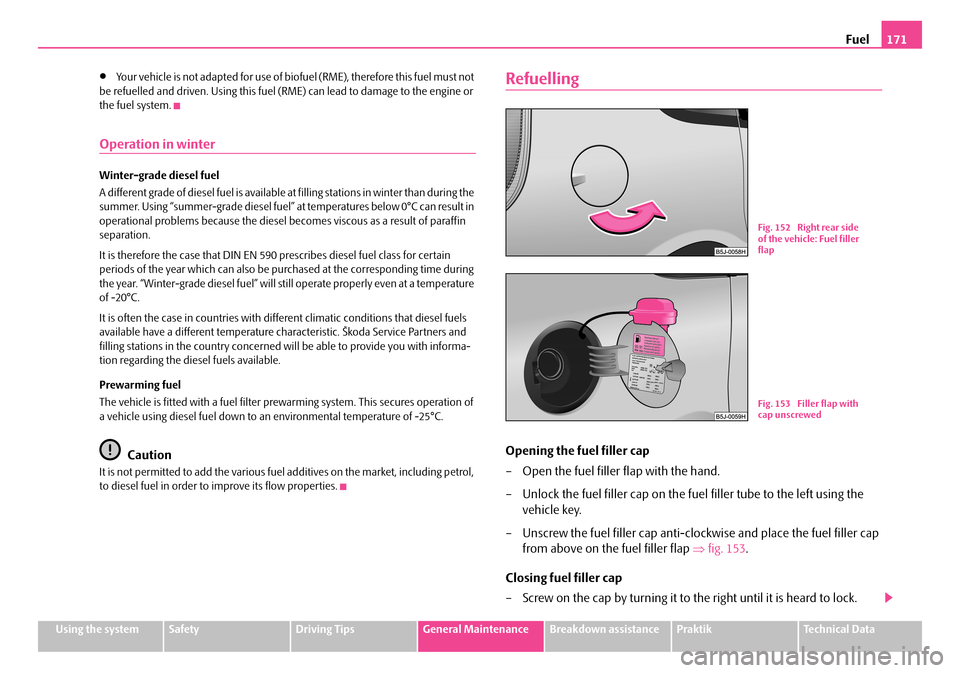
Fuel171
Using the systemSafetyDriving TipsGeneral MaintenanceBreakdown assistancePraktikTechnical Data
•Your vehicle is not adapted for use of biofuel (RME), therefore this fuel must not be refuelled and driven. Using this fuel (RME) can lead to damage to the engine or the fuel system.
Operation in winter
Winter-grade diesel fuel
A different grade of diesel fuel is available at filling stations in winter than during the summer. Using “summer-grade diesel fuel” at temperatures below 0°C can result in operational problems because the diesel be comes viscous as a result of paraffin separation.
It is therefore the case that DIN EN 590 prescribes diesel fuel class for certain periods of the year which can also be pu rchased at the corresponding time during the year. “Winter-grade diesel fuel” will still operate properly even at a temperature of -20°C.
It is often the case in countries with diff erent climatic conditions that diesel fuels available have a different temperature characteristic. Škoda Service Partners and filling stations in the count ry concerned will be able to provide you with informa- tion regarding the diesel fuels available.
Prewarming fuel
The vehicle is fitted with a fuel filter prewarming system. This secures operation of a vehicle using diesel fuel down to an environmental temperature of -25°C.
Caution
It is not permitted to add the various fuel additives on the market, including petrol, to diesel fuel in order to improve its flow properties.
Refuelling
Opening the fuel filler cap
– Open the fuel filler flap with the hand.
– Unlock the fuel filler cap on the fuel filler tube to the left using the
vehicle key.
– Unscrew the fuel filler cap anti-clo ckwise and place the fuel filler cap
from above on the fuel filler flap ⇒fig. 153.
Closing fuel filler cap
– Screw on the cap by turning it to the right until it is heard to lock.
Fig. 152 Right rear side of the vehicle: Fuel filler flap
Fig. 153 Filler flap with cap unscrewed
NKO A05R 20 MR08.book Page 171 Wednesday, March 28, 2007 9:42 AM
Page 173 of 248
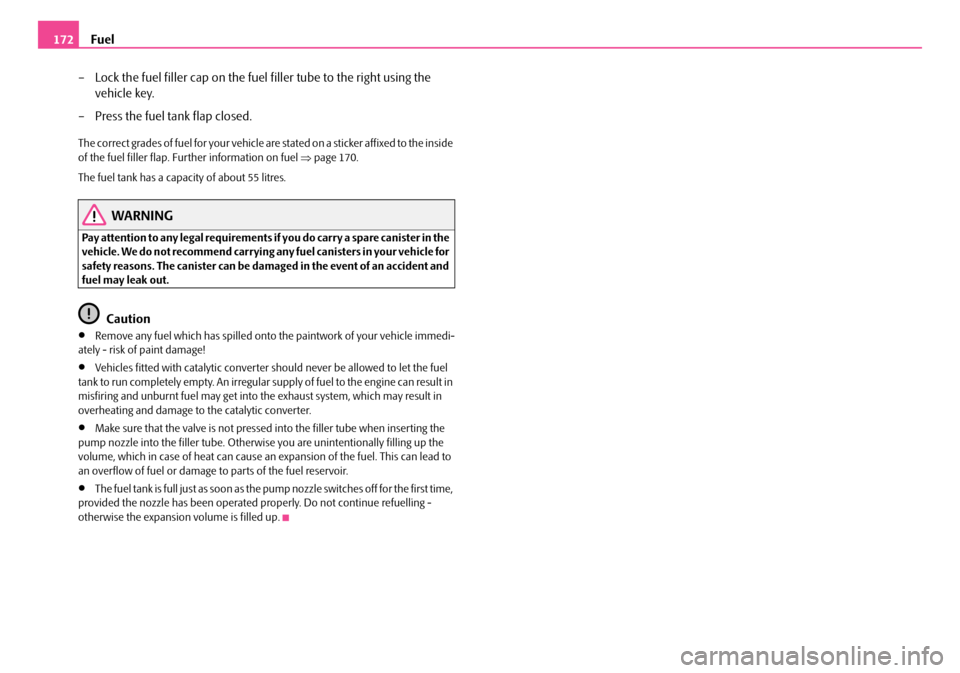
Fuel172
– Lock the fuel filler cap on the fuel filler tube to the right using the
vehicle key.
– Press the fuel tank flap closed.
The correct grades of fuel for your vehicle are stated on a sticker affixed to the inside of the fuel filler flap. Further information on fuel ⇒page 170.
The fuel tank has a capacity of about 55 litres.
WARNING
Pay attention to any legal requirements if you do carry a spare canister in the vehicle. We do not recommend carrying any fuel canisters in your vehicle for safety reasons. The canister can be da maged in the event of an accident and fuel may leak out.
Caution
•Remove any fuel which has spilled onto the paintwork of your vehicle immedi- ately - risk of paint damage!
•Vehicles fitted with catalytic converter should never be allowed to let the fuel tank to run completely empty. An irregular supply of fuel to the engine can result in misfiring and unburnt fuel may get into the exhaust system, which may result in overheating and damage to the catalytic converter.
•Make sure that the valve is not pressed into the filler tube when inserting the pump nozzle into the filler tube. Otherwis e you are unintentionally filling up the volume, which in case of heat can cause an expansion of the fuel. This can lead to an overflow of fuel or damage to parts of the fuel reservoir.
•The fuel tank is full just as soon as the pump nozzle switches off for the first time, provided the nozzle has been operated properly. Do not continue refuelling - otherwise the expansion volume is filled up.
NKO A05R 20 MR08.book Page 172 Wednesday, March 28, 2007 9:42 AM
Page 174 of 248
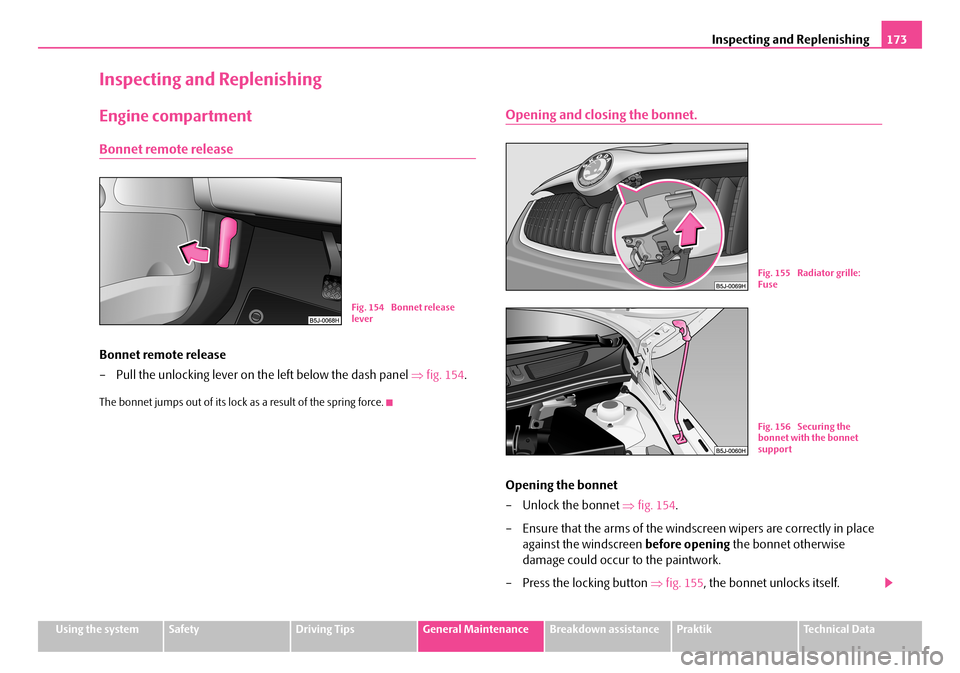
Inspecting and Replenishing173
Using the systemSafetyDriving TipsGeneral MaintenanceBreakdown assistancePraktikTechnical Data
Inspecting and Replenishing
Engine compartment
Bonnet remote release
Bonnet remote release
– Pull the unlocking lever on th e left below the dash panel ⇒fig. 154.
The bonnet jumps out of its lock as a result of the spring force.
Opening and closing the bonnet.
Opening the bonnet
– Unlock the bonnet ⇒fig. 154.
– Ensure that the arms of the windscreen wipers are correctly in place
against the windscreen before opening the bonnet otherwise
damage could occur to the paintwork.
– Press the locking button ⇒fig. 155, the bonnet unlocks itself.
Fig. 154 Bonnet release lever
Fig. 155 Radiator grille: Fuse
Fig. 156 Securing the bonnet with the bonnet support
NKO A05R 20 MR08.book Page 173 Wednesday, March 28, 2007 9:42 AM
Page 175 of 248
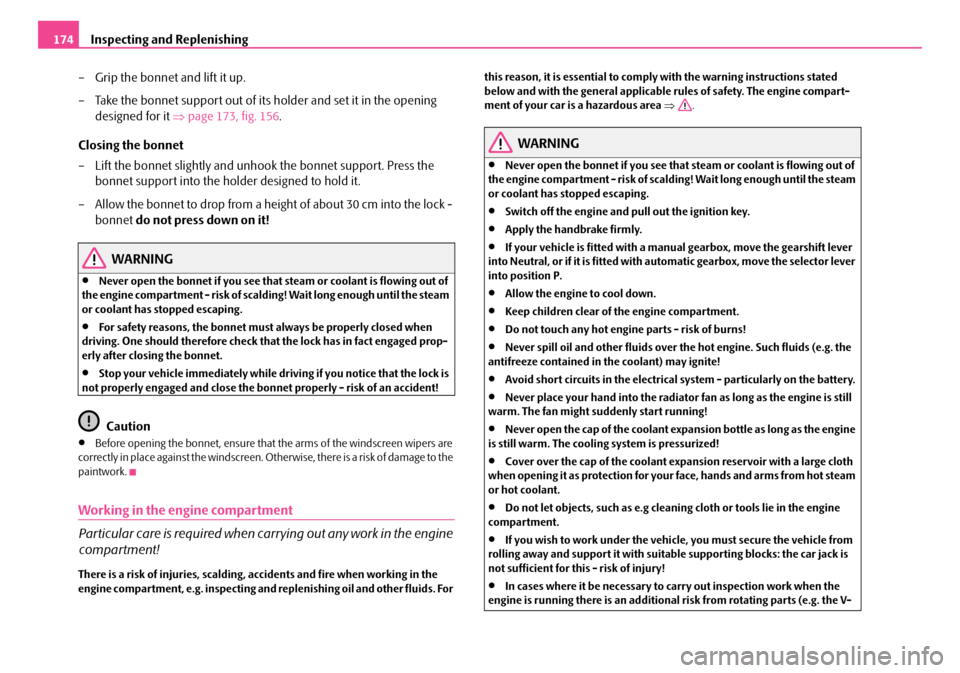
Inspecting and Replenishing174
– Grip the bonnet and lift it up.
– Take the bonnet support out of its holder and set it in the opening
designed for it ⇒page 173, fig. 156.
Closing the bonnet
– Lift the bonnet slightly and unhook the bonnet support. Press the
bonnet support into the hold er designed to hold it.
– Allow the bonnet to drop from a height of about 30 cm into the lock -
bonnet do not press down on it!
WARNING
•Never open the bonnet if you see that steam or coolant is flowing out of the engine compartment - risk of scaldi ng! Wait long enough until the steam or coolant has stopped escaping.
•For safety reasons, the bonnet must always be properly closed when driving. One should therefore check that the lock has in fact engaged prop- erly after closing the bonnet.
•Stop your vehicle i mmediately while driving if you notice that the lock is not properly engaged and close the bonn et properly - risk of an accident!
Caution
•Before opening the bonnet, ensure that the arms of the windscreen wipers are correctly in place against the windscreen. Otherwise, there is a risk of damage to the paintwork.
Working in the engine compartment
Particular care is required when ca rrying out any work in the engine
compartment!
There is a risk of injuries, scalding, accidents and fire when working in the engine compartment, e.g. inspecting an d replenishing oil and other fluids. For
this reason, it is essential to comply with the warning instructions stated below and with the general applicable rules of safety. The engine compart-ment of your car is a hazardous area ⇒.
WARNING
•Never open the bonnet if you see that steam or coolant is flowing out of the engine compartment - risk of scaldi ng! Wait long enough until the steam or coolant has stopped escaping.
•Switch off the engine and pull out the ignition key.
•Apply the handbrake firmly.
•If your vehicle is fitted with a manual gearbox, move the gearshift lever into Neutral, or if it is fitted with automatic gearbox, move the selector lever into position P.
•Allow the engine to cool down.
•Keep children clear of the engine compartment.
•Do not touch any hot engine parts - risk of burns!
•Never spill oil and other fluids over the hot engine. Such fluids (e.g. the antifreeze contained in the coolant) may ignite!
•Avoid short circuits in the electrical system - particularly on the battery.
•Never place your hand into the radiator fan as long as the engine is still warm. The fan might suddenly start running!
•Never open the cap of the coolant expa nsion bottle as long as the engine is still warm. The cooling system is pressurized!
•Cover over the cap of the coolant expansion reservoir with a large cloth when opening it as protection for your face, hands and arms from hot steam or hot coolant.
•Do not let objects, such as e.g cleaning cloth or tools lie in the engine compartment.
•If you wish to work under the vehicl e, you must secure the vehicle from rolling away and support it with suitable supporting blocks: the car jack is not sufficient for this - risk of injury!
•In cases where it be necessary to carry out inspection work when the engine is running there is an additional risk from rotating parts (e.g. the V-
NKO A05R 20 MR08.book Page 174 Wednesday, March 28, 2007 9:42 AM
Page 176 of 248

Inspecting and Replenishing175
Using the systemSafetyDriving TipsGeneral MaintenanceBreakdown assistancePraktikTechnical Data
ribbed belt, alternator, radiator fan) and from the high-voltage ignition system. Please observe in addition the following:
− Never touch the electrical cables of the ignition system.
− Absolutely avoid any jewellery, loose items of clothing or long hair from getting into the rotating parts of the engine - Hazard! Therefore remove any jewellery beforehand, tie up your hair and wear tight fitting clothing.
•Please also comply with the warnin g instructions stated below when carrying out any essential work on the fuel system or on the electrical system:
− Always separate the car battery from the electrical system.
− Do not smoke.
− Never carry out any work close to naked flames.
− Always keep a working fire extinguisher at hand.
Caution
When replenishing fluids in the engine, always ensure that the fluids are on no account mixed up. This may result in ma jor operating problems and also vehicle damage!
Overview of the engine compartment
The main inspection points
Fig. 157 Diesel engine 1.9 litre/77 kW
Coolant expansion bottle . . . . . . . . . . . . . . . . . . . . . . . . . . . . . . . . . . .
Windshield washer fluid reservoir . . . . . . . . . . . . . . . . . . . . . . . . . . .
Engine oil filler opening . . . . . . . . . . . . . . . . . . . . . . . . . . . . . . . . . . . .
Engine oil dipstick . . . . . . . . . . . . . . . . . . . . . . . . . . . . . . . . . . . . . . . . . .
Brake fluid reservoir . . . . . . . . . . . . . . . . . . . . . . . . . . . . . . . . . . . . . . . .
Battery (below a cover) . . . . . . . . . . . . . . . . . . . . . . . . . . . . . . . . . . . . .
Note
The location of the inspection points in the engine compartment of petrol and diesel engines is practically identical.
WARNING (continued)
B5J-0061H
A1179
A2186
A3178
A4177
A5181
A6182
NKO A05R 20 MR08.book Page 175 Wednesday, March 28, 2007 9:42 AM
Page 177 of 248
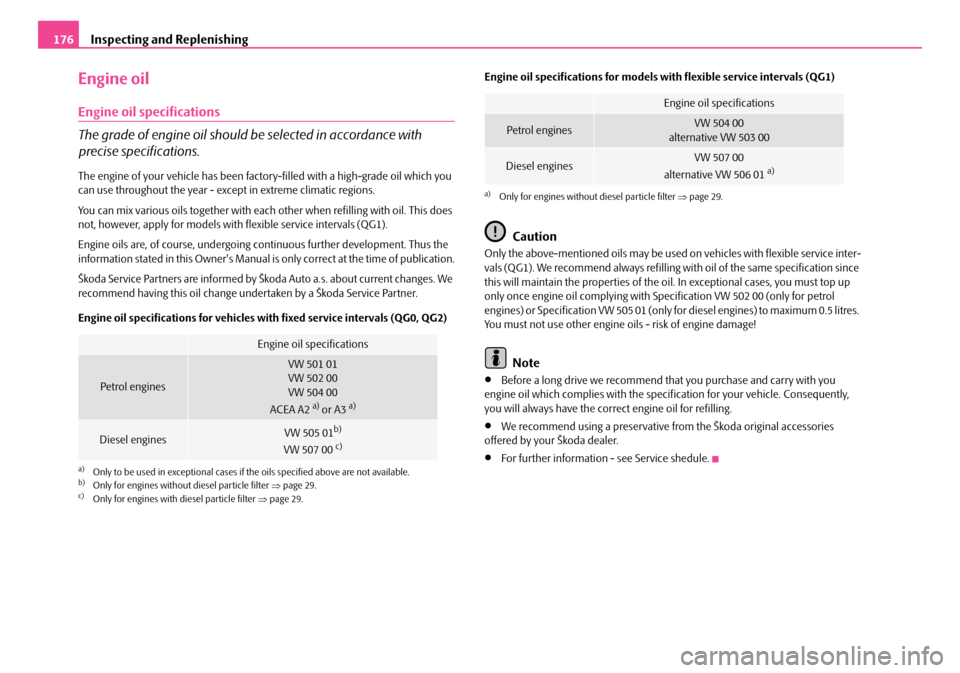
Inspecting and Replenishing176
Engine oil
Engine oil specifications
The grade of engine oil should be selected in accordance with
precise specifications.
The engine of your vehicle has been fact ory-filled with a high-grade oil which you can use throughout the year - exce pt in extreme climatic regions.
You can mix various oils together with each other when refilling with oil. This does not, however, apply for models with flexible service intervals (QG1).
Engine oils are, of course, undergoing co ntinuous further development. Thus the information stated in this Owner's Manual is only correct at the time of publication.
Škoda Service Partners are informed by Škoda Auto a.s. about current changes. We recommend having this oil change und ertaken by a Škoda Service Partner.
Engine oil specifications for vehicles with fixed service intervals (QG0, QG2)
Engine oil specifications for models with flexible service intervals (QG1)
Caution
Only the above-mentioned oils may be used on vehicles with flexible service inter- vals (QG1). We recommend always refilling with oil of the same specification since this will maintain the properties of the oi l. In exceptional cases, you must top up only once engine oil complying with Specification VW 502 00 (only for petrol engines) or Specification VW 505 01 (only for diesel engines) to maximum 0.5 litres. You must not use other engine oi ls - risk of engine damage!
Note
•Before a long drive we recommend that you purchase and carry with you engine oil which complies with the specif ication for your vehicle. Consequently, you will always have the correct engine oil for refilling.
•We recommend using a preservative fr om the Škoda original accessories offered by your Škoda dealer.
•For further information - see Service shedule.
Engine oil specifications
Petrol engines
VW 501 01 VW 502 00 VW 504 00
ACEA A2 a) or A3 a)
a)Only to be used in exceptional cases if the oils specified above are not available.
Diesel enginesVW 505 01b)
VW 507 00 c)
b)Only for engines without diesel particle filter ⇒page 29.c)Only for engines with diesel particle filter ⇒page 29.
Engine oil specifications
Petrol enginesVW 504 00 alternative VW 503 00
Diesel enginesVW 507 00
alternative VW 506 01 a)
a)Only for engines without diesel particle filter ⇒page 29.
NKO A05R 20 MR08.book Page 176 Wednesday, March 28, 2007 9:42 AM
Page 178 of 248

Inspecting and Replenishing177
Using the systemSafetyDriving TipsGeneral MaintenanceBreakdown assistancePraktikTechnical Data
Check engine oil level
The dipstick indicates the level of oil in the engine.
Checking the oil level
– Park the vehicle on a horizontal surface.
– Switch the engine off.
– Open the bonnet ⇒ in “Working in the engine compartment” on
page 174.
– Wait a few minutes and pull out the oil dipstick ⇒.
– Wipe off the dipstick with a clea n cloth and insert it again fully.
– Then withdraw the dipstick ag ain and read off the oil level.
Oil level within range
– You must not top up the oil.
Oil level within range
– You may top up the oil. It is possible that the oil level may then be
within range after doing this.
Oil level within range
–You must top up the oil. It is sufficient, once this is done, to keep the
oil level is within range .
It is normal for the engine to consume oi l. The oil consumption may be as much as 0.5 l/1 000 km depending on your style of driving and the conditions under which you operate your vehicle. The oil consumpt ion may be slightly higher than this during the first 5 000 kilometres.
One should therefore check the oil level at regular intervals, preferably every time after the fuel tank is filled or after driving for long stretches.
We recommend maintaining the oil level within the range if the engine has been operating at high loads, for example during a lengthy motorway trip during the summer months, towing a trailer or negotiating a high mountain pass, but not above this .
The warning light in the instrument cluster* will indicate ⇒page 25 whether the oil level is too low. In this case, check the oil level as soon as possible. Top up with an appropriate quantity of oil.
WARNING
Read and observe the warning notes ⇒page 174, “Working in the engine compartment” before working in the engine compartment.
Caution
•Always check the oil level on vehicles with engine 1.2 l/51 kW when the engine is warm. Otherwise the measuring result is incorrect und oil could be incorrectly replenished - risk of engine damage!
•The oil level must on no account ex tend beyond the range . Danger of damaging the cata lytic converter.
•Do not continue your journey if for some reason it is not possible under the conditions prev ailing to top up with oil. Switch the engine off and obtain profes- sional assistance from a specialist garage, otherwise it could lead to severe engine damage.
Fig. 158 Dipstick
Aa
Ab
Aa
Ac
Ab
Ab
Aa
NKO A05R 20 MR08.book Page 177 Wednesday, March 28, 2007 9:42 AM
Page 179 of 248
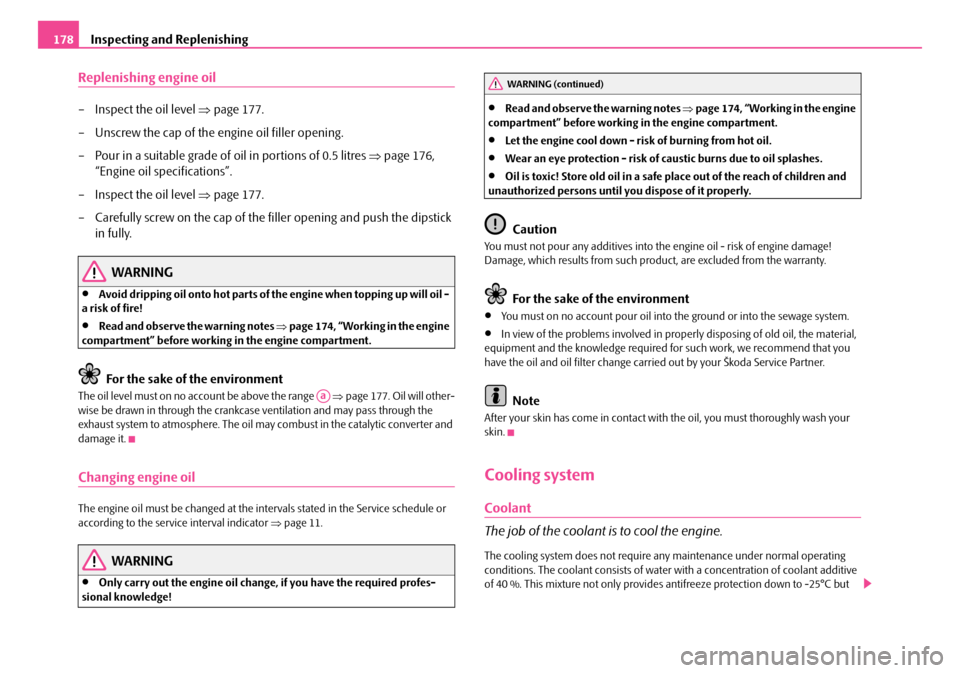
Inspecting and Replenishing178
Replenishing engine oil
– Inspect the oil level ⇒page 177.
– Unscrew the cap of the engine oil filler opening.
– Pour in a suitable grade of oil in portions of 0.5 litres ⇒page 176,
“Engine oil specifications”.
– Inspect the oil level ⇒page 177.
– Carefully screw on the cap of the filler opening and push the dipstick
in fully.
WARNING
•Avoid dripping oil onto hot parts of the engine when topping up will oil - a risk of fire!
•Read and observe the warning notes ⇒page 174, “Working in the engine compartment” before working in the engine compartment.
For the sake of the environment
The oil level must on no account be above the range ⇒page 177. Oil will other- wise be drawn in through the crankcas e ventilation and may pass through the exhaust system to atmosphere. The oil ma y combust in the catalytic converter and damage it.
Changing engine oil
The engine oil must be changed at the intervals stated in the Service schedule or according to the service interval indicator ⇒page 11.
WARNING
•Only carry out the engine oil change, if you have the required profes- sional knowledge!
•Read and observe the warning notes ⇒page 174, “Working in the engine compartment” before working in the engine compartment.
•Let the engine cool down - risk of burning from hot oil.
•Wear an eye protection - risk of caustic burns due to oil splashes.
•Oil is toxic! Store old oil in a safe place out of the reach of children and unauthorized persons until you dispose of it properly.
Caution
You must not pour any additives into th e engine oil - risk of engine damage! Damage, which results from such produc t, are excluded from the warranty.
For the sake of the environment
•You must on no account pour oil into the ground or into the sewage system.
•In view of the problems involved in properly disposing of old oil, the material, equipment and the knowledge required fo r such work, we recommend that you have the oil and oil filter change carr ied out by your Škoda Service Partner.
Note
After your skin has come in contact with the oil, you must thoroughly wash your skin.
Cooling system
Coolant
The job of the coolant is to cool the engine.
The cooling system does not require an y maintenance under normal operating conditions. The coolant consis ts of water with a concentration of coolant additive of 40 %. This mixture not only provides antifreeze protection down to -25°C but
Aa
WARNING (continued)
NKO A05R 20 MR08.book Page 178 Wednesday, March 28, 2007 9:42 AM
Page 180 of 248
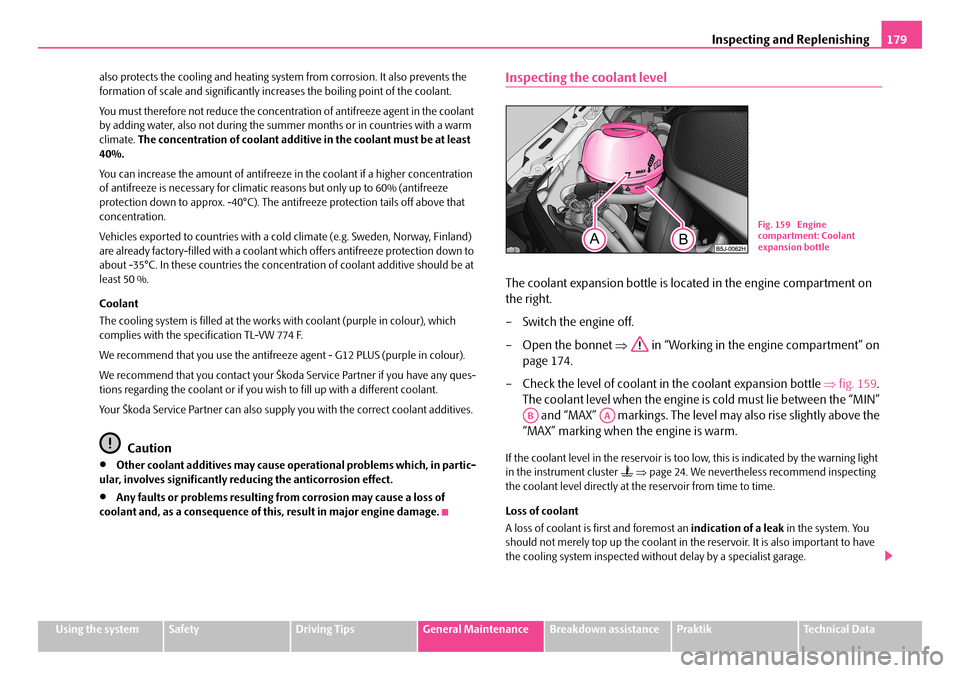
Inspecting and Replenishing179
Using the systemSafetyDriving TipsGeneral MaintenanceBreakdown assistancePraktikTechnical Data
also protects the cooling and heating system from corrosion. It also prevents the formation of scale and significantly increases the boiling point of the coolant.
You must therefore not reduce the concentr ation of antifreeze agent in the coolant by adding water, also not during the summ er months or in countries with a warm climate. The concentration of coolant additive in the coolant must be at least 40%.
You can increase the amount of antifreeze in the coolant if a higher concentration of antifreeze is necessary for climatic reasons but only up to 60% (antifreeze protection down to approx. -40°C). The an tifreeze protection tails off above that concentration.
Vehicles exported to countries with a co ld climate (e.g. Sweden, Norway, Finland) are already factory-filled with a coolant wh ich offers antifreeze protection down to about -35°C. In these countries the concentr ation of coolant additive should be at least 50 %.
Coolant
The cooling system is filled at the works with coolant (purple in colour), which complies with the specification TL-VW 774 F.
We recommend that you use the antifreeze agent - G12 PLUS (purple in colour).
We recommend that you contact your Škod a Service Partner if you have any ques- tions regarding the coolant or if you wish to fill up with a different coolant.
Your Škoda Service Partner can also suppl y you with the correct coolant additives.
Caution
•Other coolant additives may cause operational problems which, in partic- ular, involves significantly redu cing the anticorrosion effect.
•Any faults or problems resulting from corrosion may cause a loss of coolant and, as a consequence of th is, result in major engine damage.
Inspecting the coolant level
The coolant expansion bottle is located in the engine compartment on
the right.
– Switch the engine off.
– Open the bonnet ⇒ in “Working in the engine compartment” on
page 174.
– Check the level of coolant in the coolant expansion bottle ⇒fig. 159.
The coolant level when the engine is cold must lie between the “MIN”
and “MAX” markings. The level may also rise slightly above the
“MAX” marking when the engine is warm.
If the coolant level in the reservoir is too low, this is indicated by the warning light in the instrument cluster ⇒page 24. We nevertheless recommend inspecting the coolant level directly at the reservoir from time to time.
Loss of coolant
A loss of coolant is first and foremost an indication of a leak in the system. You should not merely top up the coolant in the reservoir. It is also important to have the cooling system inspected without delay by a specialist garage.
Fig. 159 Engine compartment: Coolant expansion bottle
ABAA
NKO A05R 20 MR08.book Page 179 Wednesday, March 28, 2007 9:42 AM